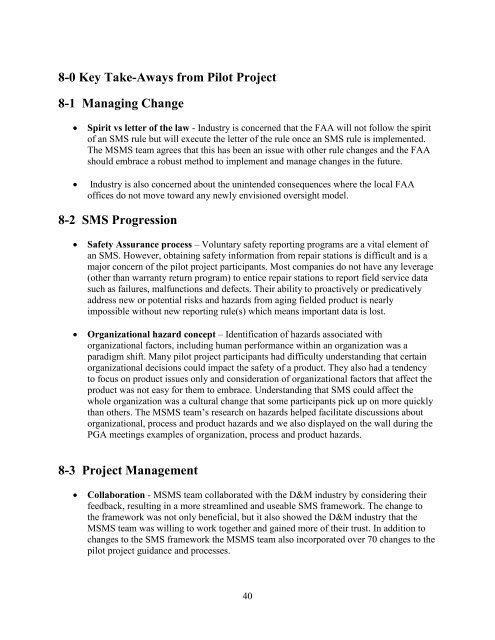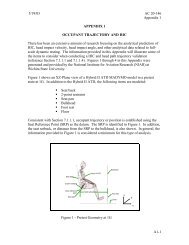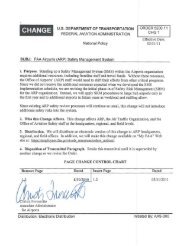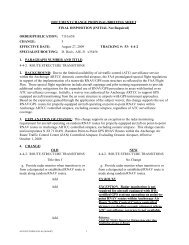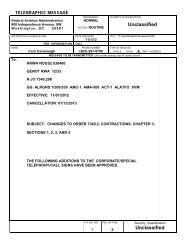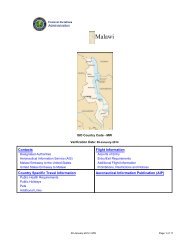2009 SMS Pilot Project (SMSPP) Analysis - FAA
2009 SMS Pilot Project (SMSPP) Analysis - FAA
2009 SMS Pilot Project (SMSPP) Analysis - FAA
You also want an ePaper? Increase the reach of your titles
YUMPU automatically turns print PDFs into web optimized ePapers that Google loves.
8-0 Key Take-Aways from <strong>Pilot</strong> <strong>Project</strong><br />
8-1 Managing Change<br />
• Spirit vs letter of the law - Industry is concerned that the <strong>FAA</strong> will not follow the spirit<br />
of an <strong>SMS</strong> rule but will execute the letter of the rule once an <strong>SMS</strong> rule is implemented.<br />
The M<strong>SMS</strong> team agrees that this has been an issue with other rule changes and the <strong>FAA</strong><br />
should embrace a robust method to implement and manage changes in the future.<br />
• Industry is also concerned about the unintended consequences where the local <strong>FAA</strong><br />
offices do not move toward any newly envisioned oversight model.<br />
8-2 <strong>SMS</strong> Progression<br />
• Safety Assurance process – Voluntary safety reporting programs are a vital element of<br />
an <strong>SMS</strong>. However, obtaining safety information from repair stations is difficult and is a<br />
major concern of the pilot project participants. Most companies do not have any leverage<br />
(other than warranty return program) to entice repair stations to report field service data<br />
such as failures, malfunctions and defects. Their ability to proactively or predicatively<br />
address new or potential risks and hazards from aging fielded product is nearly<br />
impossible without new reporting rule(s) which means important data is lost.<br />
• Organizational hazard concept – Identification of hazards associated with<br />
organizational factors, including human performance within an organization was a<br />
paradigm shift. Many pilot project participants had difficulty understanding that certain<br />
organizational decisions could impact the safety of a product. They also had a tendency<br />
to focus on product issues only and consideration of organizational factors that affect the<br />
product was not easy for them to embrace. Understanding that <strong>SMS</strong> could affect the<br />
whole organization was a cultural change that some participants pick up on more quickly<br />
than others. The M<strong>SMS</strong> team’s research on hazards helped facilitate discussions about<br />
organizational, process and product hazards and we also displayed on the wall during the<br />
PGA meetings examples of organization, process and product hazards.<br />
8-3 <strong>Project</strong> Management<br />
• Collaboration - M<strong>SMS</strong> team collaborated with the D&M industry by considering their<br />
feedback, resulting in a more streamlined and useable <strong>SMS</strong> framework. The change to<br />
the framework was not only beneficial, but it also showed the D&M industry that the<br />
M<strong>SMS</strong> team was willing to work together and gained more of their trust. In addition to<br />
changes to the <strong>SMS</strong> framework the M<strong>SMS</strong> team also incorporated over 70 changes to the<br />
pilot project guidance and processes.<br />
40


